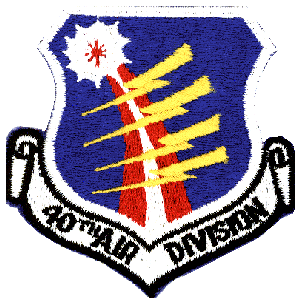 |
40th Air Division Insignia
|
The 40th Air Division began as the 40th Bombardment Wing on Jan. 15, 1943.
Assigned to the Third Air Force, it was activated at MacDill Field, Fl.
Less that six months later the wing found itself at Brampton Gange,
Huntingdonshire, England, reassigned to Eighth Air Force and the VIII Bomber
Command.
No combat groups were assigned to the wing at the time the organization
arrived in England and little is known of their activities.
Redesignated the 40th Combat Bombardment Wing (Heavy) in August 1943, the
wing was given three bombardment groups - the 92nd, the 305th, and the 306th..
The wing immediately began actions against industrial targets, U-boat plants,
marshalling yards and V-bomb launching sites.
For "extraordinary heroism, determination and esprit de corps in action
against the enemy" the 40th and its assigned groups were awarded the
Distinguished Unit Citation. The 40th served in combat in the European theater
from September 1943 until April 1945. They remained in Europe until being
inactivated in Germany, Dec. 25, 1946.
New life came five years later when the wing was redesignated, Headquarters
40th Air Division, March 2, 1951 and assigned to Strategic Air Command. Their
base of operation was Turner AFB, GA.
Enjoying a brief leadership as a three-wing, two base organization, the
division, by the end of the year, became something of a skeleton organization.
By Jan. 1, 1952 it was reduced to a one-officer, one-airman status. Six months
later, however, the division regained its two-wing status.
Two years later a high point occurred in the division with the announcement
that they had been awarded the MacKay Trophy for executing the most meritorious
flight of the year 1953.
The next major event was the division's inactivation on April 1, 1957.
The 40th Air Division reactivated in July 1959 assigned to the Strategic Air
Command's Eighth Air Force and headquartered at Wurtsmith AFB, Mich.
The Division was the parent unit of four SAC wings and advisor to three
Aerial Reserve Force units. The Division's mission was to supervise and monitor
the operation of the 379th and 410th Bombardment Wings, the 305th Aerial
Refueling Wing, the 351st Strategic Missile Wing, the 128th Aerial Refueling
Group, and the 931st Aerial Refueling Group.
Through inspection and assistance visits, the Division insured that each of
these units was capable of executing SAC's emergency war order mission.
Whiteman AFB
Whiteman AFB is the home of the 351st Strategic Missile Wing which controls
150 Minuteman II missiles, scattered throughout a 16,000 square mile area in
west-central Missouri.
The base, first activated in 1942, served as a glider training location.
Whiteman itself covers some 3,400 acres and has about 3,200 people assigned. The
base was named in honor of Lt. George A. Whiteman, a former native of Sedalia
who was killed in action at Pearl Harbor and became the first American airman to
die in World War II.
Gen. Mitchell Field
Home of the 128th Aerial Refueling Group is General Mitchell Air National
Guard Base at Milwaukee, Wis. The Group began in 1947 as a fighter interceptor
squadron. It converted to KC-97s in 1961. The group was assigned to SAC in 1976.
They received their first KC-135 on December 2nd 1977. The base was named in
honor of Brig. Gen. William "Billy" Mitchell an airpower advocate and pioneer in
aviation techniques. The parent Wing for the 128th is the 126th Aerial Refueling
Wing.
K. I. Sawyer AFB
K. I. Sawyer AFB is the home of the 410th Bombardment Wing which controls the
644th Bombardment Squadron and the 46th Aerial Refueling Squadron. The base was
located near Marquette, Michigan in the upper peninsula. The base was activated
by military personnel in 1956, but the runway was not officially opened until
late October 1959. It was named after Kenneth I. Sawyer, a former Marquette
County road commissioner. K. I. Sawyer covers 5,181 acres of land and had about
4,800 people assigned. The base was also home to the 87th Fighter Interceptor
Squadron.
Grissom AFB
Grissom AFB was the home of the 305th Aerial Refueling Wing, the 931st Aerial
Refueling Group (Air Force Reserve) and the 434th Tactical Fighter Wing (AFR).
The base, originally Bunker Hill Naval Air Station built in 1942, is located
north of Indianapolis, Indiana.
The base was transferred from Navy to the Air Force and Strategic Air Command
assumed jurisdiction in September 1957.
The base was renamed in May 1968 in honor of Air Force Lt. Col. Virgil I.
"Gus" Grissom, and Indiana native and one of the original seven U. S.
astronauts.
The base was located on nearly 3,000 acres of land and had some 3,300 people
assigned. Grissom was also a home for SAC's EC-135 a flying radio relay station
in support of the Airborne Command Post.
Wurtsmith AFB
Wurtsmith was home for the 379th Bombardment Wing which controlled the 524th
Bombardment Squadron and the 920th Aerial Refueling Squadron. The base began in
1923 as a landing area for Army aircraft from Selfridge Field, near Detroit. It
was formally named Paul B. Wurtsmith AFB in July 1953 after Michigan's World War
II hero, a major general, died in an aircraft accident. The base was signed over
to SAC in April 1960. The base located about 2 miles west of Oscoda. Wurtsmith
encompasses some 5,200 acres of land and had about 3,500 people assigned. It was
also home for Headquarters 40th Air Division.
O'Hare International
Chicago's O'Hare International Airport is home for the 126th Aerial Refueling
Wing of the Illinois National Guard.